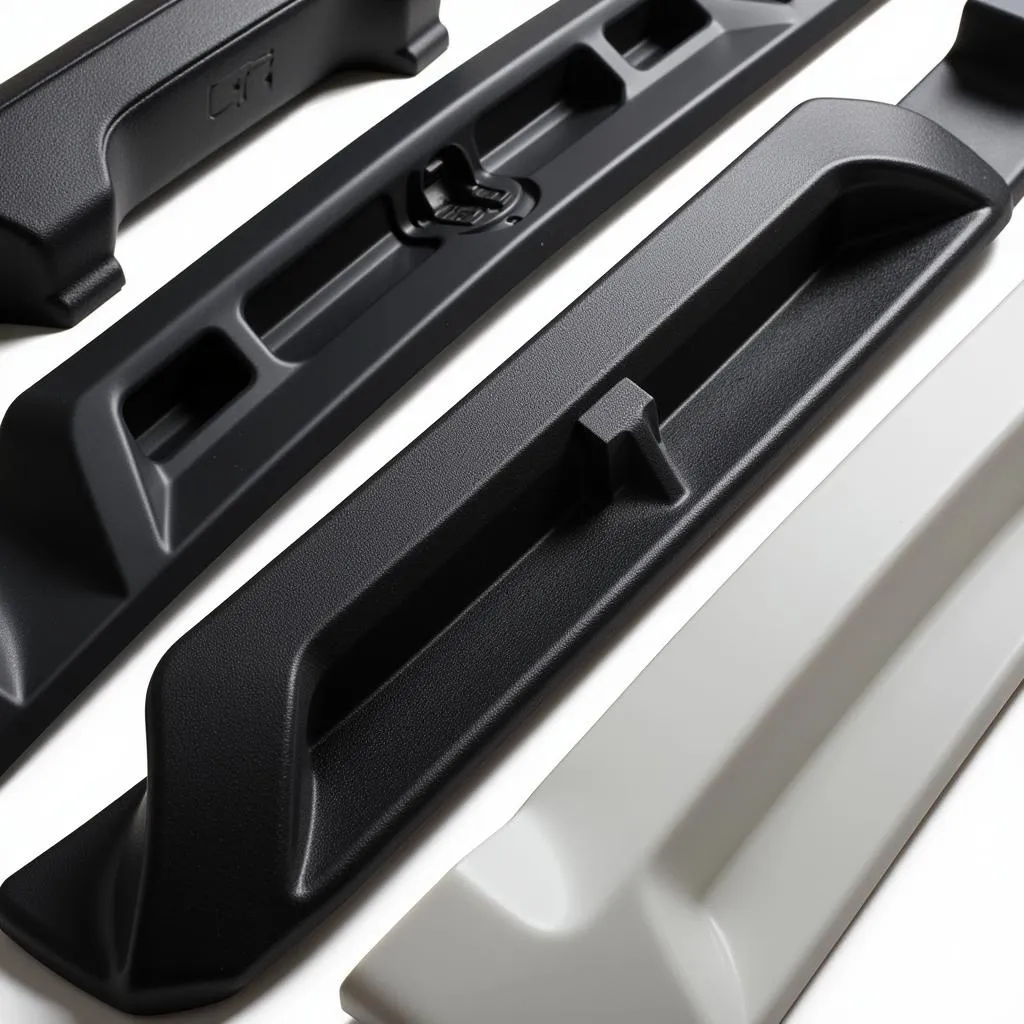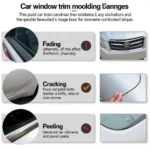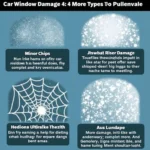Whether you’re a seasoned car enthusiast or a new driver, dealing with a damaged car bumper can be frustrating. Fortunately, plastic car bumper repair is often more straightforward and affordable than you might think. This guide dives deep into the intricacies of fixing those unsightly scrapes, dents, and cracks, empowering you to restore your car’s appearance and potentially save a significant amount of money.
Understanding Plastic Car Bumpers
Before delving into repair techniques, it’s essential to understand the materials involved. Most modern cars feature bumpers made from thermoplastic polymers, which are designed to flex and absorb minor impacts. This flexibility, however, also makes them susceptible to scratches and dents.
Common Plastic Bumper Damage
Plastic bumpers often bear the brunt of minor collisions, parking mishaps, and even encounters with rogue shopping carts. Here are some of the most common types of damage:
- Scratches: Ranging from light surface marks to deeper grooves that expose the underlying plastic.
- Dents: Concave depressions caused by impacts, varying in size and depth.
- Cracks: Linear fractures in the bumper, often resulting from more severe impacts.
- Tears: Jagged openings or separations in the plastic, typically caused by forceful impacts.
DIY Plastic Bumper Repair: Is It Feasible?
The good news is that many types of plastic bumper damage can be addressed with DIY repair methods, saving you a trip to the auto body shop. However, extensive damage or complex repairs might require professional intervention.
Assessing the Damage: Repair or Replace?
Before you begin, carefully inspect the damage to your bumper. Minor scratches and dents are usually repairable, while severe cracks, tears, or extensive damage might necessitate a complete bumper replacement. Consider the cost of repair materials versus the price of a new bumper when making your decision.
Essential Tools and Materials for Plastic Bumper Repair
- Cleaning Supplies: Soap, water, microfiber cloths, wax and grease remover.
- Sandpaper: Assorted grits (e.g., 180, 320, 400, 600) for smoothing and preparing the surface.
- Plastic Filler/Body Filler: For filling dents, cracks, and deeper scratches.
- Putty Knife: For applying and smoothing filler.
- Primer: Promotes paint adhesion and provides a uniform surface for painting.
- Automotive Paint: Color-matched to your car’s finish.
- Clear Coat: Protects the paint and adds shine.
- Masking Tape and Paper: To protect surrounding areas during the repair process.
- Safety Equipment: Gloves, eye protection, and a respirator mask.
Step-by-Step Guide to Repairing Plastic Car Bumpers
-
Clean the Damaged Area: Thoroughly wash the bumper with soap and water, ensuring it’s free from dirt, debris, and grease. Use a wax and grease remover for optimal results.
-
Sand the Damaged Area: Start with coarser grit sandpaper (180) to level out any protruding edges or uneven surfaces. Gradually progress to finer grits (320, 400), feathering the edges to create a smooth transition.
-
Apply Plastic Filler (if necessary): For dents, cracks, or deeper scratches, use a putty knife to apply plastic filler to the affected area. Overfill slightly, as the filler will shrink as it dries. Allow ample drying time as per the manufacturer’s instructions.
-
Sand the Filler Smooth: Once the filler dries completely, sand it down using progressively finer grits of sandpaper (starting with 320 and ending with 600) until it’s flush with the surrounding bumper surface.
-
Mask Surrounding Areas: Use masking tape and paper to protect areas you don’t want to paint, such as headlights, trim, and body panels.
-
Apply Primer: Apply thin, even coats of primer to the repaired area, extending slightly beyond the edges to ensure proper coverage. Allow each coat to dry completely before applying the next.
-
Sand the Primer (if necessary): If needed, lightly sand the primer with fine-grit sandpaper (400 or 600) to create a smooth surface for paint application.
-
Apply Automotive Paint: Shake the paint can thoroughly and apply thin, even coats to the primed area, using a sweeping motion. Allow each coat to dry completely before applying the next.
-
Apply Clear Coat: Once the final coat of paint dries, apply 2-3 coats of clear coat for added protection and shine. Allow each coat to dry completely before applying the next.
-
Remove Masking Tape: Carefully peel away the masking tape while the clear coat is still slightly tacky. This helps prevent the paint from peeling.
-
Buff and Polish (optional): For a professional finish, you can use a buffing compound and a polisher to remove any imperfections and enhance the shine.
When to Seek Professional Plastic Bumper Repair
- Extensive Damage: If the bumper has severe cracks, tears, or significant structural damage, professional repair might be necessary.
- Airbag Deployment: If the damage to your bumper was caused by an accident that deployed the airbags, it’s crucial to have the entire bumper system inspected by a qualified mechanic to ensure structural integrity and proper airbag functionality.
- Lack of Experience: If you’re uncomfortable performing the repair yourself, it’s always best to seek professional assistance.
Preventing Future Plastic Bumper Damage
- Park Strategically: Choose parking spots away from high-traffic areas or potential hazards like shopping carts.
- Maintain a Safe Distance: Leave ample space between your car and the vehicle in front of you to avoid fender benders.
- Install Bumper Protectors: Consider adding bumper guards or protectors to minimize damage from minor impacts.
By understanding the basics of plastic car bumper repair, you can confidently tackle those minor blemishes and restore your car’s appearance. Remember to always prioritize safety and seek professional assistance when in doubt.
FAQs About Plastic Car Bumper Repair
1. Can I use regular paint on a plastic car bumper?
No, regular paint won’t adhere properly to plastic. You’ll need to use specialized automotive paint designed for plastic bumpers to ensure proper adhesion and a durable finish.
2. How long does it take for plastic filler to dry?
Drying times vary depending on the type of filler used and environmental conditions. However, most plastic fillers require at least 24 hours to fully cure before sanding and painting.
3. Can I repair a cracked plastic bumper myself?
While it’s possible to repair minor cracks using plastic welding or epoxy adhesives, larger cracks or tears often require professional repair to ensure structural integrity.
4. How can I prevent my car bumper from fading?
Regularly washing and waxing your car can help protect the paint and prevent fading caused by UV rays. Parking in shaded areas can also minimize sun exposure.
5. How much does it cost to repair a plastic car bumper professionally?
The cost of professional repair varies depending on the extent of the damage, the type of repair required, and the labor rates in your area. It’s always a good idea to get multiple quotes from reputable auto body shops.
For those looking to repair deeper scratches on their plastic car bumpers, we have a detailed guide available on how to repair deep scratch on plastic car bumper.
If you’re unsure about the repairability of your bumper, we encourage you to check out our article on can you repair plastic car bumpers.
Remember, taking care of your car’s appearance can make all the difference in its overall value and your enjoyment of driving it. Need further assistance? Feel free to reach out to our team via WhatsApp at +1(641)206-8880 or email us at [email protected]. We are available 24/7 to address your concerns and provide expert advice.



